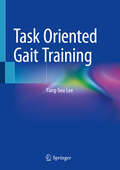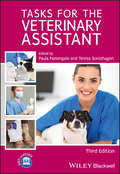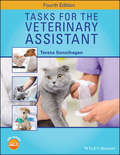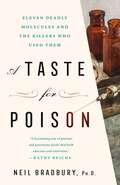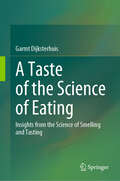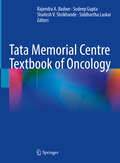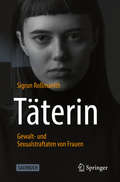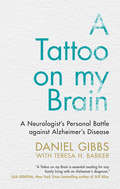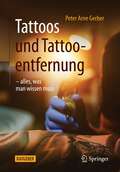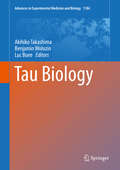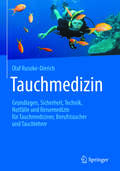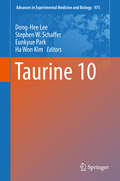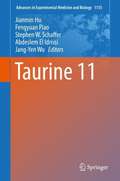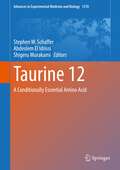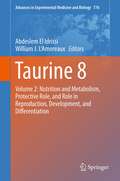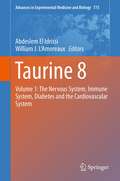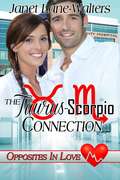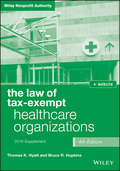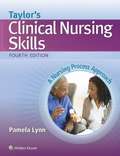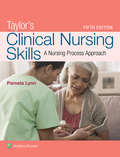- Table View
- List View
The Task Force for Child Survival: Secrets of Successful Coalitions
by William W. FoegeHow did coalition-building give rise to the incredible achievements of the Task Force for Childhood Survival?Dr. Bill Foege, one of the best-known names in global health, brings readers to the table during the creation of one of the world’s most famous and successful global health efforts—the Task Force for Child Survival.In 1984, the US immunization program was so successful that many childhood diseases were at record lows—yet 40,000 children a day were dying around the world from preventable diseases. That year, Dr. Foege, former director of the Centers for Disease Control and Prevention, came together with Jonas Salk, Robert McNamara, and representatives from UNICEF, the World Health Organization, the World Bank, the United Nations Development Programme, and the Rockefeller Foundation to see how some of the lessons learned in America could be applied to global programs. The assembled participants recommended the formation of a small task force to help UN agencies improve immunization coverage. They dubbed it the Task Force for Child Survival and installed Foege as its first leader.In this book, Dr. Foege describes the task force from its conception through its landmark success. Over its first six years, as more resources were allocated to the task force, immunization coverage climbed from approximately 15 percent of the world’s children for some vaccines to 80 percent of the world’s children for at least one vaccine. UNICEF head Jim Grant called it the greatest peacetime endeavor the world had ever seen. How did this small, independent, low-profile group leverage change in the largest of global health agencies? Foege dissects each element for clues as to why the task force was able to accomplish so much so quickly, ultimately concluding that coalition-building played a major role and explaining how to strengthen coalitions by scrupulously avoiding the turf guarding and credit seeking that are so common to international endeavors.Inspiring and accessible, this brief book combines the distilled advice of one of global health's major leaders with the history of an iconic public health program.
Task Oriented Gait Training
by Yang-Soo LeeSafe and independent gait is one of the most important physical function of human. Gait training is essential to people with gait difficulty. Although there are many types of gait training strategy, there are no consensus on which one is the best. Gait training strategy can be divided into compensatory approaches and restorative approaches. Although people with severe impairment wish to restore normal walking, it is too difficult to use their involved body part normally in gait. Also, people use compensatory approaches in gait even in training session. Therefore forced use of involved body part is indispensable in gait training topeople with severe impairment. This book introduces new gait training frame which uses forced use of affected body part. First, strengthening of weakened muscle, second, step up with affected lower limb, third, step down with weight support with affected lower limb, and fourth is step down touch. Actual gait training starts after people can support their body weight and maintain balance with affected lower limb, without using hand. With this approach, people can restore impaired body function, regain more normal gait, and canreach optimal outcome.
Tasks for the Veterinary Assistant
by Paula Pattengale Teresa SonsthagenTasks for the Veterinary Assistant, Third Edition provides practical, step-by-step instructions for preparing and performing a wide range of veterinary assisting tasks. With expanded coverage of large animal and exotic restraint, anatomy and physiology, nutrition and feeding, digital radiography, and electronic medical records and client communication, this revised edition now includes why and when to perform each task with the preparation and procedure information. The book includes everything from appearance and professional language to equipment maintenance and dental and surgical assisting, making it equally useful for learning new techniques or as a memory refresher.Offering a detailed, comprehensive guide to all aspects of veterinary assisting, the book is written using an accessible, user-friendly style. A companion website offers figures from the book, downloadable flash cards, lesson plans, exams, a competency checklist, and concept maps. Tasks for the Veterinary Assistant is equally useful for acquiring new skills and gaining confidence in the veterinary practice, making it invaluable for veterinary assistant students and veterinary assistants of all experience levels.
Tasks for the Veterinary Assistant
by Teresa SonsthagenTasks for the Veterinary Assistant is the definitive, practical guide to the vital skills and techniques used in daily practice—bringing together all the information necessary to succeed as a veterinary assistant in one reader-friendly volume. Now in its fourth edition, this classic text has been completely revised to adopt a concise approach to learning that is ideally suited for modern readers. More and improved images, streamlined chapters, and easily-referenced key topics help readers understand the important aspects of real-world practice. Updated chapters cover infectious disease protocols, clinical procedures, and patient care and management. New chapters cover exam and treatment room skills, and present information on small animals, laboratory animals, and large animals. This re-envisioned new edition: Covers every task and technique that veterinary assistants encounter daily Offers step-by-step guidance for fundamental veterinary skills, procedures, and practices Provides quick and easy reference to a comprehensive range of central topics Uses a new, larger page size to better fit content and enhance searching for information when on the job Includes access to a companion website presenting quizzes and exercises, flashcards, teaching resources, psychomotor tests, a downloadable competency record, and more Tasks for the Veterinary Assistant, Fourth Edition continues to be the definitive text for trainee and practicing veterinary assistants in clinical, laboratory, or research settings.
A Taste for Poison: Eleven Deadly Molecules and the Killers Who Used Them
by Neil Bradbury“A fascinating tale of poisons and poisonous deeds which both educates and entertains.” --Kathy ReichsA brilliant blend of science and crime, A TASTE FOR POISON reveals how eleven notorious poisons affect the body--through the murders in which they were used. As any reader of murder mysteries can tell you, poison is one of the most enduring—and popular—weapons of choice for a scheming murderer. It can be slipped into a drink, smeared onto the tip of an arrow or the handle of a door, even filtered through the air we breathe. But how exactly do these poisons work to break our bodies down, and what can we learn from the damage they inflict? In a fascinating blend of popular science, medical history, and true crime, Dr. Neil Bradbury explores this most morbidly captivating method of murder from a cellular level. Alongside real-life accounts of murderers and their crimes—some notorious, some forgotten, some still unsolved—are the equally compelling stories of the poisons involved: eleven molecules of death that work their way through the human body and, paradoxically, illuminate the way in which our bodies function. Drawn from historical records and current news headlines, A Taste for Poison weaves together the tales of spurned lovers, shady scientists, medical professionals and political assassins to show how the precise systems of the body can be impaired to lethal effect through the use of poison. From the deadly origins of the gin & tonic cocktail to the arsenic-laced wallpaper in Napoleon’s bedroom, A Taste for Poison leads readers on a riveting tour of the intricate, complex systems that keep us alive—or don’t.
A Taste of the Science of Eating: Insights from the Science of Smelling and Tasting
by Garmt DijksterhuisWhy do you taste what you taste, and what about smelling? Many books address good food, but few go deeper, explaining the processes behind smelling and tasting. The book addresses the senses of smell and taste and the many more senses and their interactions during eating. It also stresses the importance of psychology when you smell, taste and eat. Some of the other topics include flavour, the working of the nose and olfactory (cross-)adaptation, the use of odorants, the relation between emotion and eating, and many more. The book helps you understand why you like and eat food, and shows the intriguing complexity of the area.
Tata Memorial Centre Textbook of Oncology
by Rajendra A. Badwe Sudeep Gupta Shailesh V. Shrikhande Siddhartha LaskarThe Tata Memorial Centre Textbook of Oncology is an authoritative and comprehensive book, meticulously compiled to cover contemporary issues in oncology. It features contributions from 189 authors, culminating in 76 chapters. Authored by faculty members from the renowned Tata Memorial Centre, this textbook offers a harmonious blend of detailed information and practical approaches. It serves as a comprehensive resource that contextualizes the practice of oncology in TMC and offers insights into delivering high-quality cancer care in diverse settings. It offers an authentic overview of the TMC approach to multidisciplinary cancer care. The Textbook is designed to cater to a wide array of readers – from undergraduate medical students to postgraduates specializing in general surgery, general medicine, pediatrics, gynecology, radiation oncology, and other disciplines, and practicing community oncologists. A notable feature of the Textbook is its utility in preparing students for entrance and exit examinations. This book is an essential resource for established cancer specialists, including surgeons, medical oncologists, radiation oncologists, and those in allied fields. It is also invaluable for super-specialty students and postgraduates with an interest in cancer management, offering a comprehensive guide to the dynamic field of oncology.
Täterin - Gewalt- und Sexualstraftaten von Frauen
by Sigrun RoßmanithFrauen tun doch sowas nicht Frauen als Täterinnen von Gewalt- und Sexualdelikten - ein Tabu? Frauen werden nicht aus sich heraus gewalttätig - ein Irrtum! Es gibt sie, diese dunkle Seite der weiblichen Seele. Frauen verstümmeln, quälen, töten. Sie misshandeln ihre Kinder, auch sexuell, doch die Gesellschaft blendet das aus. Warum? Die Psychiaterin und Gerichtsgutachterin Sigrun Roßmanith greift dieses Thema auf, das seit Jahrzehnten ihr Spezialgebiet ist. Sie beleuchtet zunächst die geschichtlichen, kulturellen und wissenschaftlichen Hintergründe des Tabus „Frau als Täterin“. Ihre Analysen der Auslöser, Motive und des forensisch-psychiatrischen Kontextes zeigen die Realität femininer Destruktivität wertfrei, ohne zu richten oder zu beschönigen: Mütter, die töten, Vergewaltigerinnen, Stalkerinnen, Auftragskillerinnen und vieles mehr - keine Taten, die nicht auch von weiblicher Hand verübt werden. So nimmt sie den interessierten Leser auf Basis ihrer jahrzehntelangen Berufserfahrung, der kein Krimi das Wasser reichen kann, mit auf eine packende Reise in die Abgründe der weiblichen Natur.
A Tattoo on my Brain: A Neurologist's Personal Battle against Alzheimer's Disease
by Daniel Gibbs Teresa H. BarkerDr Daniel Gibbs is one of 50 million people worldwide with an Alzheimer's disease diagnosis. Unlike most patients with Alzheimer's, however, Dr Gibbs worked as a neurologist for twenty-five years, caring for patients with the very disease now affecting him. Also unusual is that Dr Gibbs had begun to suspect he had Alzheimer's several years before any official diagnosis could be made. Forewarned by genetic testing showing he carried alleles that increased the risk of developing the disease, he noticed symptoms of mild cognitive impairment long before any tests would have alerted him. In this highly personal account, Dr Gibbs documents the effect his diagnosis has had on his life and explains his advocacy for improving early recognition of Alzheimer's. Weaving clinical knowledge from decades caring for dementia patients with his personal experience of the disease, this is an optimistic tale of one man's journey with early-stage Alzheimer's disease.
A Tattoo on my Brain: A Neurologist's Personal Battle against Alzheimer's Disease
by Daniel Gibbs Teresa H. BarkerDr Daniel Gibbs is one of 50 million people worldwide with an Alzheimer's disease diagnosis. Unlike most patients with Alzheimer's, however, Dr Gibbs worked as a neurologist for twenty-five years, caring for patients with the very disease now affecting him. Also unusual is that Dr Gibbs had begun to suspect he had Alzheimer's several years before any official diagnosis could be made. Forewarned by genetic testing showing he carried alleles that increased the risk of developing the disease, he noticed symptoms of mild cognitive impairment long before any tests would have alerted him. In this highly personal account, Dr Gibbs documents the effect his diagnosis has had on his life and explains his advocacy for improving early recognition of Alzheimer's. Weaving clinical knowledge from decades caring for dementia patients with his personal experience of the disease, this is an optimistic tale of one man's journey with early-stage Alzheimer's disease. Soon to be a documentary film on MTV/Paramount +.
Tattoos und Tattooentfernung: -alles, was man wissen muss
by Peter Arne GerberAlles was Sie heute zu Tätowierungen wissen sollten. Am besten noch bevor Sie sich Ihre Tätowierung stechen lassen! Von Fachexperten in einem Buch zusammengefasst! In Deutschland sind aktuell mehr als 12 Millionen Menschen tätowiert, wovon ein Großteil gleich mehrere Tätowierungen in der Haut trägt – Tendenz unvermindert steigend. Das Thema der bunten Körperverzierung als Stärkungsform der eigenen Individualität, Modeaccessoire oder „Just for Fun“, rückt dabei immer mehr in den Fokus verschiedenster Zielgruppen. Seien es die Kulturgeschichte der Tätowierung, die psychologischen Hintergründe, warum sich Menschen unabhängig ihrer Abstammung, Kultur oder Sichtweise weltweit tätowieren lassen oder auch gesundheitliche Aspekte von Tattoos und Tattooentfernung – das Thema Tätowierung bietet zahlreiche spannende Facetten. Mit diesem vorliegenden Ratgeber wenden sich professionelle Tätowierer, Mediziner, Psychologen, Historiker und führende Experten erstmals gemeinsam mit ihrem gesammelten Know-how und relevanten Fakten nach dem aktuellen Stand des Wissens an Tattoo-Träger und jene, die es eventuell bald sein möchten. Mit ausgewiesener Expertise werden Tipps gegeben und Fragen beantwortet. Wo kommt das Tattoo her? Was muss man vor dem Tätowieren beachten und wie finde ich meinen Tattoo-Artist? Welche Risiken und Nebenwirkungen können auftreten und wie kann ich später mein Tattoo-Motiv verändern oder komplett entfernen lassen?
Tau Biology (Advances in Experimental Medicine and Biology #1184)
by Akihiko Takashima Benjamin Wolozin Luc BueeThis book presents essential studies and cutting-edge research results on tau, which is attracting increasing interest as a target for the treatment of Alzheimer's disease. Tau is well known as a microtubule-associated protein that is predominantly localized in the axons of neurons. In various forms of brain disease, neuronal loss occurs, with deposition of hyperphosphorylated tau in the remaining neurons. Important questions remain regarding the way in which tau forms hyperphosphorylated and fibrillar deposits in neurons, and whether tau aggregation represents the toxic pathway leading to neuronal death. With the help of new technologies, researchers are now solving these long-standing questions. In this book, readers will find the latest expert knowledge on all aspects of tau biology, including the structure and role of the tau molecule, tau localization and function, the pathology, drivers, and markers of tauopathies, tau aggregation, and treatments targeting tau. Tau Biology will be an invaluable source of information and fresh ideas for those involved in the development of more effective therapies and for all who seek a better understanding of the biology of the aging brain.
Tauchmedizin: Grundlagen, Sicherheit, Technik, Notfälle und Reisemedizin für Tauchmediziner, Berufstaucher und Tauchlehrer
by Olaf Rusoke-DierichDieses Buch liefert aktuelles Wissen rund um die Tauchmedizin und das Tauchen und wendet sich an alle Tauchmediziner, Berufstaucher und Tauchlehrer. Es umfasst nicht nur die klassischen Bereiche der Tauchmedizin, sondern auch angrenzende Bereiche wie Tauchgeschichte, Ausr#65533;stung, Wiederbelebung, umwelt- und atemgasbedingte Sch#65533;digungen, Tauchtauglichkeit sowie reisemedizinische Aspekte. Ein weiterer wichtiger Bestandteil dieses Buches ist auch die ausf#65533;hrliche Darstellung der modernen Dekompressionstheorie.
Taurine 10 (Advances in Experimental Medicine and Biology #975)
by Dong-Hee Lee, Stephen W. Schaffer, Eunkyue Park and Ha Won KimTaurine 10 contains original articles and critical reviews based on the oral and poster presentations of XX International Taurine Meeting held in Seoul, Korea in May 2016. The purpose of the book is to present current ideas, new avenues and research regarding biological functions and clinical applications of taurine and taurine derivatives. It focuses on all aspects of taurine research including the cardiovascular system, the immune system, diabetes, the central nervous system, endocrine system and the role of taurine supplements in nutrition. It also includes presentations of novel animal experimental models using Cdo1 and CSAD knock-out mice.
Taurine 11 (Advances in Experimental Medicine and Biology #1155)
by Abdeslem El Idrissi Stephen W. Schaffer Jianmin Hu Fengyuan Piao Jang-Yen WuThis book gathers a selection of original articles and critical reviews presented at the 21st International Taurine Meeting, held in Shenyang, China in May 2018, which discussed and disseminated the latest findings on taurine, especially in human life. The book is divided into eight parts, which respectively address: Taurine and Metabolism, Taurine and Nutrition, Taurine and Organ Dysfunction, Taurine and Heart Health, Taurine and Anti-cancer, Taurine and Anti-oxidation / Anti-microbial, Taurine and Neuroprotection, and Taurine and Anti-inflammatory. These latest discoveries concerning the functions and advantageous effects of taurine on the health of various human body systems will not only advance the treatment of human diseases and the quality of human life, but also promote further research into the applications of taurine in human health.
Taurine 12: A Conditionally Essential Amino Acid (Advances in Experimental Medicine and Biology #1370)
by Stephen W. Schaffer Abdeslem El Idrissi Shigeru MurakamiThis volume gathers a selection of original articles and reviews on timely topics about the application of Taurine in human health written by members of the International Taurine Society, including COVID-19, cancer, heart disease, and diabetes, among others. Chapters are written by Taurine experts across the globe in North and South America, Asia, and Europe. A majority of the articles are based on original studies recently carried out in individual laboratories worldwide. The book is divided into eight parts, each covering a unique aspect of Taurine. Each section will highlight new research findings on Taurine and its application in various human systems, including the nervous system, immune system, and cardiovascular system, to combat disease. The first section covers COVID-19, the dominant health event of 2020. Experts will explore and clarify the potential therapeutic effectiveness of Taurine against COVID-19. The volume will promote further research into the application of Taurine in human health, and will be of use to a wide audience, including basic and clinical scientists, pharmaceutical and nutraceutical companies, and libraries.
Taurine 8: Nutrition and Metabolism, Protective Role, and Role in Reproduction, Development, and Differentiation
by Abdeslem El Idrissi William J. L'AmoreauxTaurine 8 represents the combined efforts of investigators on the roles of the amino acid taurine on human health and disease. The chapters covered in this book are directly derived from presentations of the contributors at the 18th International Taurine Meeting held in Marrakech, Morocco in April 2012. The purpose of this book is to disseminate current findings on taurine's contribution in several organ systems. This book covers the following topics: Taurine in Nutrition and Metabolism, the Protective Role of Taurine, and the Role of Taurine in Reproduction, Development, and Differentiation. Dr. Abdeslem El Idrissi, College of Staten Island and Dr. William L'Amoreaux, College of Staten Island, were co-chairs of the Organizing Committee for the meeting. Data presented at this meeting provided compelling evidence that taurine is not only cytoprotective in cardiomyocytes, but also is a potent GABA agonist, whereby it can facilitate vasodilation of conducting arteries. Taurine conjugates, such as taurine chloramine, may protect cells from oxidative stress via increased HO-1 expression. In adult rodents, taurine has a potent effect on plasma glucose levels, likely through the release of insulin in pancreatic beta cells. As a potential neurotransmitter, taurine is known to work via the GABAergic system, but current research presented at this meeting suggest that taurine may interact with glutamate and serotonin receptors as well. Data are also presented to demonstrate the protective roles of taurine on neurons in neuroblastoma. Perhaps the most important and exciting presentation is the role of taurine and alcohol: the combination may be lethal. Data are also presented at this meeting of the potential role taurine may have as an adjuvant treatment with cisplatin in chemotherapy.
Taurine 8: The Nervous System, Immune System, Diabetes and the Cardiovascular System
by Abdeslem El Idrissi William J. L'AmoreauxTaurine 8 represents the combined efforts of investigators on the roles of the amino acid taurine on human health and disease. The chapters covered in this book are directly derived from presentations of the contributors at the 18th International Taurine Meeting held in Marrakech, Morocco in April 2012. The purpose of this book is to disseminate current findings on taurine's contribution in several organ systems. This book covers the following topics: Taurine in the Nervous System, Taurine in the Immune System, Taurine and Diabetes, and Taurine and the Cardiovascular System. Dr. Abdeslem El Idrissi, College of Staten Island and Dr. William L’Amoreaux, College of Staten Island, were co-chairs of the Organizing Committee for the meeting. Data presented at this meeting provided compelling evidence that taurine is not only cytoprotective in cardiomyocytes, but also is a potent GABA agonist, whereby it can facilitate vasodilation of conducting arteries. Taurine conjugates, such as taurine chloramine, may protect cells from oxidative stress via increased HO-1 expression. In adult rodents, taurine has a potent effect on plasma glucose levels, likely through the release of insulin in pancreatic beta cells. As a potential neurotransmitter, taurine is known to work via the GABAergic system, but current research presented at this meeting suggest that taurine may interact with glutamate and serotonin receptors as well. Data are also presented to demonstrate the protective roles of taurine on neurons in neuroblastoma. Perhaps the most important and exciting presentation is the role of taurine and alcohol: the combination may be lethal. Data are also presented at this meeting of the potential role taurine may have as an adjuvant treatment with cisplatin in chemotherapy.
The Taurus-Scorpio Connection (Opposites in Love, Medical Zodiac Romances #2)
by Janet Lane-Walters Canada Jude PittmanCan these two find a way to uncover the underhanded events at the hospital? They’re on opposite sides but the attraction between them is strong. She’s a widow who fought to save her husband’s life during a code. She feels guilty because the love she and her husband shared had died before his death. He assisted at the code but he feels guilty since he was the one who was responsible for the short staffing the night her husband died. Now they face falling in love and trying to solve the problems between the nurse’s union and the president of the hospital’s Board who wants a take over of the hospital by his hospital group. Is their connection strong enough to survive?
Tax-Exempt Healthcare 2016 Supplement
by Thomas K. HyattGet up to date on 2016 healthcare law and newly relevant issues The Law of Tax-Exempt Healthcare Organizations 2016 Supplement provides complete and comprehensive practitioner updates and analysis in a single volume. Tackling complex legal issues with plain-English explanations and the appropriate citations, this guide is a must-have resource for organizations and their advisors. This new supplement to the Fourth Edition has been fully updated with the latest IRS guidance and requirements, and expanded with additional coverage of relevant topics. The new discussion includes healthcare reform and the Affordable Care Act, the fiduciary duty of directors on the governing body of nonprofit organizations, executive compensation, activities of tax-exempt organizations that appear more commercial than charitable, political campaign activity, charitable reforms, restrictions on supporting organizations, intermediate sanctions, and much more. The companion website provides extensive appendices for further reference, as well as helpful downloadable tables that facilitate a more efficient approach to practice. Healthcare law is a complex field, and keeping up with the frequent changes to federal law is itself a full time job. This book eliminates the need for extended research time by collecting all of the newest and relevant guidelines into one place. Get up to date on the latest IRS forms, guidance, and procedures Interpret complex legal issues correctly and appropriately Reference relevant federal guidelines quickly and easily Access extensive appendices and tables to streamline application As the field evolves and new issues arise, practitioners need a working knowledge of the legal implications behind organizational activities, structure, practices, and more. This most recent annual supplement to The Law of Tax-Exempt Healthcare Organizations is a must-have resource for anyone in the field.
Taxing Soda for Public Health
by Yann Le Bodo Marie-Claude Paquette Philippe De WalsThis timely reference analyzes the rationale, impact, and feasibility of taxation of sugar-sweetened beverages (SSBs) as a public health measure to contribute curbing obesity and diabetes rates, specifically in Canada. It presents the pros and cons of taxing soda, with the latest data on adverse health effects of its consumption, plus the various business and political issues surrounding the contentious proposition. Reviewed research is multidisciplinary, spanning health and medicine to ethics, economics, and law. Conclusions and caveats are clear and presented at a comfort level for the general reader. The result is a blueprint for analyzing the relevancy of taxes on sweetened soft drinks or other low-nutrition food products, plus a trove of valuable insights into aspects of government decision-making and consumer food behavior. Included in the coverage: · Reasons for specifically targeting SSBs · SSB taxation as a public health policy instrument · Effects of SSB taxation on energy intakes and population health · Potential undesirable effects relating to SSB taxation · Social and political acceptability of SSB taxation · Evaluability of SSB taxation Taxing Soda for Public Health will interest policymakers, public health professionals, advocacy groups, and researchers at the Canadian and international levels (e. g. , in areas such as public health, nutrition, food and health policies, health economics, and evaluation), as well as students and all other parties interested in nutrition policies.
Taylor's Clinical Nursing Skills: A Nursing Process Approach, Fourth Edition
by Pamela LynnTaylor's Clinical Nursing Skills: A Nursing Process Approach aims to help nursing students or graduate nurses incorporate cognitive, technical, interpersonal, and ethical/ legal skills into safe and effective patient care. This book is written to meet the needs of novice to advanced nurses. Many of the skills shown in this book may not be encountered by the student while in school, but may be encountered once the graduate nurse has entered the workforce.
Taylor's Clinical Nursing Skills: A Nursing Process Approach
by Pamela Lynn<p>Confidently meet the challenges of person-centered nursing practice! <p>From basic nursing processes to advanced clinical capabilities, Taylor’s Clinical Nursing Skills: A Nursing Process Approach helps you hone your cognitive, technical, interpersonal, and ethical/legal capabilities and master patient interaction, clinical reasoning, and communication skills essential to safe and effective person-centered care. <p>Step-by-step, evidence-based guidelines walk you through common practices and simplify complex procedures, accompanied by key considerations for documentation, delegation, and other tasks you’ll encounter throughout the nursing process, from your first day on the job to every stage of your nursing career. <p>Step-by-Step Skills are presented in a concise, straightforward, and simplified two-column format facilitating competent performance of nursing skills. Scientific Rationales accompany each nursing action to promote a deeper understanding of the basic principles supporting nursing care.</p>
Taylor's Clinical Nursing Skills: A Nursing Process Approach (Coursepoint Ser.)
by Pamela LynnPublisher’s Note: Products purchased from 3rd Party sellers are not guaranteed by the Publisher for quality, authenticity, or access to any online entitlements included with the product. Taylor’s Clinical Nursing Skills: A Nursing Process Approach Fifth Edition Pamela Lynn, EdD, MSN, RN Confidently meet the challenges of person-centered nursing practice! From basic nursing processes to advanced clinical capabilities, Taylor’s Clinical Nursing Skills: A Nursing Process Approach helps you hone your cognitive, technical, interpersonal, and ethical/legal capabilities and master patient interaction, clinical reasoning, and communication skills essential to safe and effective person-centered care. Step-by-step, evidence-based guidelines walk you through common practices and simplify complex procedures, accompanied by key considerations for documentation, delegation, and other tasks you’ll encounter throughout the nursing process, from your first day on the job to every stage of your nursing career. Step-by-Step Skills are presented in a concise, straightforward, and simplified two-column format facilitating competent performance of nursing skills. Scientific Rationales accompany each nursing action to promote a deeper understanding of the basic principles supporting nursing care. Unexpected Situations highlight abnormal outcomes while providing explanations of how to react to provide the best care. Evidence for Practice boxes present current best practice guidelines and up-to-date research relevant to the skills. A Nursing Process Framework integrates related nursing responsibilities for each of the five steps. Skill Variations provide clear, start-to-finish instructions for variations in equipment or technique. Documentation Guidelines guide you through accurate documentation of skills and findings. Hand Hygiene icons alert you to this crucial step that prevents the spread of microorganisms. Patient Identification icons help you ensure the right patient receives the intervention and prevent errors. Delegation Considerations assist you in developing the critical decision-making skills needed to transfer responsibility for the performance of an activity to another individual.
Taylor's Clinical Nursing Skills
by Pamela LynnExtensively updated with the latest evidence-based approaches, engaging learning features, and detailed, high-quality photographs, Taylor’s Clinical Nursing Skills, 6th Edition, gives students the confidence and clinical judgment to effectively incorporate cognitive, technical, interpersonal, and ethical/legal skills for exceptional patient care. This robust text guides students step-by-step through the full continuum of clinical nursing skills and complements Fundamentals of Nursing: The Art and Science of Person-Centered Care, 10th Edition to create a seamless, superior learning experience throughout the nursing curriculum and equip students for successful nursing practice.

